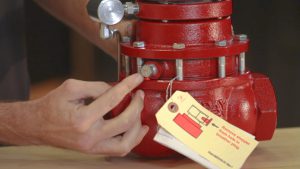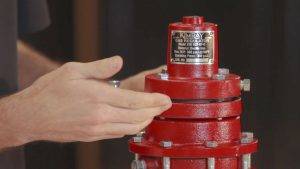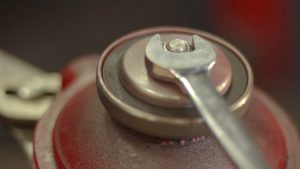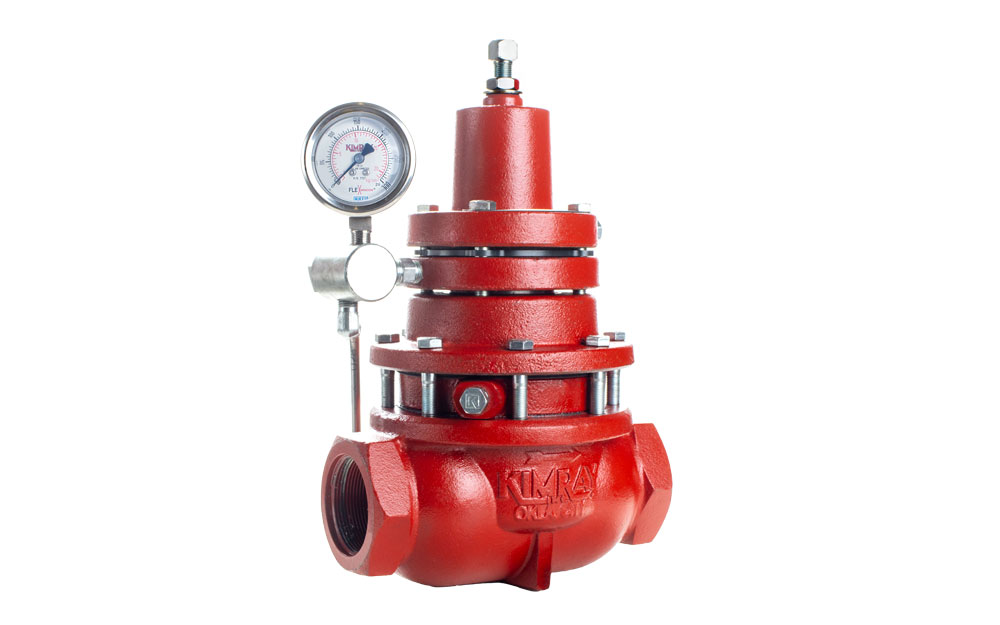
Kimray is a world-class manufacturer of Back Pressure Regulators based in Oklahoma City, Oklahoma, USA. The Back Pressure Regulator was the first product introduced back in 1948, and it continues to be one of our most popular.
This guide will cover the following topics:
- What is a Back Pressure Regulator?
- How Do Back Pressure Regulators Work?
- Troubleshooting a Back Pressure Regulator
- How to Repair a Back Pressure Regulator
- Applications for a Back Pressure Regulator
- What Options are Available?
- Questions to Ask of Your Back Pressure Valve Supplier
What is a Back Pressure Regulator?
A Back Pressure Regulator is a type of control valve designed to hold pressure on production vessels and release pressure upstream when a set point is reached. Producers use them on separators, treaters, and free water knockouts. This then allows the vessels to properly perform their function in the production process.
How Do Back Pressure Regulators Work?
The Kimray Back Pressure Regulator is considered an “integrated” valve because the pilot—the key to opening and closing the regulator—is integrated into the valve and comes out as one piece. The regulator monitors upstream pressure. To adjust the set point, turn the adjusting screw on top. The spring pushes down on the diaphragm assembly, which positions the pilot plug. The pilot plug then allows gas from upstream to push down on the diaphragm.
The flow through this regulator is from underneath the plunger. The flow pushes up on the plunger as the gas is pushing down on the diaphragm. Because the diaphragm has a larger surface area than the plunger, the same pressure can hold the regulator in a closed position. This sets a constant back pressure and the regulator will begin regulating the pressure.
If production exceeds the set point, the upstream pressure pushes up on the diaphragm assembly, closing off the supply side of the pilot plug and unseating the exhaust side. Gas then vents from the top of the diaphragm and the upstream pressure is regulated.
Troubleshooting the Back Pressure Regulator
Here are 4 things to check if your Back Pressure Regulator is not operating correctly:

1. Is the stopper still in the breather plug?
If your regulator appears to be stuck in the ON position, the small red stopper may not have been removed from the breather plug.
We put this stopper in the breather plug so oil doesn’t spill out during transportation, but it should be removed before operation. Remove this by hand.

2. Do you have wet or dirty gas?
If your regulator is venting continuously, you either have a blown diaphragm or your pilot plug can’t seat properly due to wet or dirty gas in your pipeline. First, remove the bonnet and pilot housing to access the pilot plug. Then remove, clean, and dry the pilot plug, then re-install it.
Back Pressure Regulators are typically meant for gas (though we do offer& options for

3. Is the pilot plug seat loose?
If your regulator will not open, the pilot plug seat may be loose. To address this, remove the bonnet and the pilot plug housing to access the pilot plug seat. Use a wrench to make sure the pilot plug seat is snug.

4. Is the seat nut too tight?
If your regulator is leaking downstream, the seat may have been overtightened during a repair.
The nut should be tightened down, but not to the point of causing the seat to bulge. If the seat is bulging, back the nut off a quarter turn at a time until the seat sits flat.
How to Repair the Back Pressure Regulator
Over time, the internals of the regulator experience wear and tear that can affect production processes, so it’s necessary to disassemble and replace key internal parts with a Kimray Repair Kit. In this extended repair video, Kimray Account Manager Jason Andrews will show you how to disassemble, examine, and reassemble the Kimray Back Pressure Regulator.
If you would like to advance to a specific section, you can click one of the links below:
Disassembly
- Pilot housing 1:28
- Lower seat 1:57
- Upper housing 2:18
- Removable seat 3:18
- Lower housing 4:17
- Filter 5:15
- Diaphragm plate assembly 5:51
- Inspection 6:28
Reassembly
- Removable seat 6:55
- Lower housing 7:42
- Upper housing 11:25
- Filter 12:47
- Diaphragm plate assembly 14:11
- Pilot housing 15:01
- Bonnet and tubing 16:19
Applications for the Back Pressure Regulator
The Back Pressure Regulator is a staple in oil and gas production. Producers employee it in numerous oilfield applications, including:
- Separators
- Treaters
- Free Water Knockouts
- Compressor Stations
- Gas Gathering Systems
What Options are Available?
The Kimray Back Pressure Regulator is available from 1-6″ and is available in a non-venting configuration that will help producers who need to keep emissions low as well as those operating in housed applications. It comes with different elastomers depending on the temperature and gas makeup.
We offer stainless steel options in the wetted area of the valve, and we also offer a reduced inner valve to offer better control. This regulator operates in a low pressure, oz.-20 lbs (back pressure), 3 psi-125 psi, and then from 10 psi-280 psi in this configuration.
Questions to Ask When Looking for a Back Pressure Regulator Supplier
Oil and gas control equipment is vital to the performance of your company and the safety of your people. Here are three key things you want from suppliers:
- Quality. Safety hazards abound in our industry. Quality and durability matter. Does your supplier have a reputation for quality?
- Distribution. Can your supplier get you what you need? Do they have product availability in your region?
- Support. What happens after the sale? Is there ongoing support, or does the supplier view the sale as merely a transaction?
Kimray is a globally known supplier of Back Pressure Regulators with a proven track record of creating quality products.
From our manufacturing headquarters in Oklahoma City, we ship product to a vast network of Kimray stores and authorized distributors. We have 25 distribution centers in the U.S. and international distribution partners in China, Mexico, Canada, Africa, the Middle East, India, Europe, South America, and Australia, we supply the globe with control products.
We also provide first-class product support. From accessible repair centers and knowledgeable applications technicians to our popular blog and YouTube channel, we supply our customers with the resources, people, and training to get the job done. Our mission is to make a difference in the lives of those we serve, and we do that by partnering with you to make sure our products are doing what you need them to do.




























